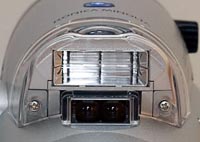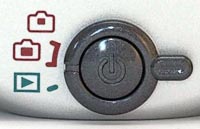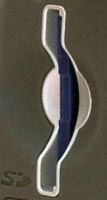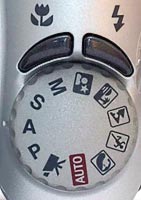Konica Minolta DiMAGE Z10
Review Date: November 29th 2004
|
Ease of Use
The Konica Minolta DiMAGE Z10 instantly reminded me of the Fuji FinePix S7000, S5000 and S20 Pro cameras that I have previously reviewed, with a large lens barrel and handgrip that dominate the overall design of the camera. Konica Minolta have given the Z10 a much more modern, almost futuristic look than those cameras, with a shiny silver body, sloping lens barrel and large flash unit. The body is entirely made out of a plastic that doesn't feel like the most durable in the world - I think this is one area where corners have been cut to keep the price as low as it is. A grippier kind of dark-grey plastic has been added to both the right and left sides of the body, where you would naturally hold it, ensuring that you can get a good grip on what is quite a large camera in terms of both dimensions and weight.
On the rear of the camera is the 1.5 inch LCD screen, which seems a little smaller than it actually is because of the large size of the camera, and the generously sized electronic viewfinder with dioptre control. Konica Minolta have come up with a novel solution to switching between the LCD screen and the EVF. Instead of having both powered on at the same time and therefore wasting vital battery life, the camera only allows you to select one or the other by using the Mode switch on the rear. If you select the LCD option, a dark cover physically slides over the EVF, and if you choose the EVF option, the cover slides over the LCD screen. This system takes a bit of getting used to at first and is undoubtedly another means of getting the price down - on previous Konica Minolta cameras like the DiMAGE 5, the switch between the LCD screen and EVF was activated by eye control, but obviously this is too complex and expensive to implement on the Z10. Having said that, the dark cover system works well enough and after a while you won't notice it when you switch from, say, EVF to Play and back again.
On the top of the camera sits the exposure mode dial, which is the equivalent to the control centre in terms of how simple or complicated you want the camera to be. If you're a beginner, choose the full Auto or Program mode, or one of the various Scene modes, and let the camera take control of setting apertures and shutter speeds whilst you concentrate on capturing the moment. If you want more control, use the A, S or the M modes so that you can tell the camera exactly what to do. Konica Minolta have used an industry standard icon system that will be instantly recognisable to anyone who has used a 35mm SLR camera before.
Next to the exposure mode dial are the Macro and Flash buttons, Nothing too exciting there, you might think, except that the Flash button can optionally be configured to select other key configuration options, such as white balance and ISO speed. Simply choose the Key func. option from the menu and then select what you want this button to control - a great way of making a particular feature that you alter a lot easily accessible and quick to operate.
The Konica Minolta DiMAGE Z10 is very well-made, despite its all-plastic construction, with nothing that feels as though it will fall off given enough wear and tear. The only thing that I wasn't that impressed with was the memory card cover, in that there isn't one as such, just a plastic flap that sits within a recess in the handgrip and which opens when you insert the card. I'm not sure if this solution will offer the best protection.
| Flash | Mode Switch |
 |
 |
Konica Minolta have done an excellent job in designing a camera that doesn't have too many external buttons and switches, especially considering the complexity and functionality of the camera. There are 11 external controls in total, with most of them clearly labeled and understandable. I was initially confused by the i+ button, which actually simply toggles between different screen display options. The shutter button is large and tactile, as are the zoom switch and the other controls on the rear of the camera, despite again being made from a rather cheap feeling plastic. The only small niggles that I had from a handling point of view were the positioning of the shutter button, which sits in a recess ( I would prefer it to be slightly raised), and the zoom switch, which is too rounded for my liking. Otherwise the Konica Minolta Z10 was a joy to use, quickly becoming second-nature.
The menu system of the Konica Minolta DiMAGE Z10 is as well designed as the exterior of the camera. Like the X50 that I reviewed last week, it uses an intuitive tabbed interface with numbered pages and a Setup option at the top of the screen. There are only ever a maximum of 5 options per page, which are all shown onscreen at the same time, so no scrolling through an endless list trying to find that elusive option. Konica Minolta have accommodated the extra features and options on the Z10 by simply adding an extra page to the interface and making the menu option text smaller. It's also great to see design consistency across models, so that upgrading from one Konica Minolta camera to another takes the minimum of effort and relearning.
So what is the Konica Minolta DiMAGE Z10 like to actually operate and take a photo? Probably due to the camera having a non-protruding zoom lens, the start-up time from turning the camera on to being ready to take a photo is very quick, taking around 1/2 second. Zooming the lens from the widest focal length to the longest is a bit slower at around 1.5 seconds, understandable given that it covers a range of 36mm to 290mm. Focusing is very quick and responsive in good light and also indoors and in low-light situations. Both the refresh rate and visibility of the LCD screen are very good and it is visible even in bright sunlight. The EVF, typically a weak point of digital cameras in the past, is large, bright and consequently very useable. Images are stored quickly with the camera ready to take another image almost instantly.
| Memory Card Slot | Macro Button / Flash Button / Exposure Dial |
 |
 |
Once you have captured a photo, the Konica Minolta DiMAGE Z10 has a lot of options when it comes to playing, reviewing and managing your images. You can scroll through the images that you have taken, zoom in and out to a factor of x6 and play a slideshow. You can rotate images, choose which images to Lock (to prevent them from being deleted), and delete an image. You can configure which images you want to print, selecting whether to print the date, how many copies you want to print and if you want to make an index print. Making a copy of an image that you have taken is also possible, and you can select images that will be attached to an email when you download onto your computer. Importantly there is a histogram to show the exposure of a recorded image, and you can also choose to display one whilst you are taking a photo.
I thoroughly enjoyed my time with the Konica Minolta DiMAGE Z10. It's a very well-designed camera that offers all of the functionality that will allow your photography to flourish, giving you full control over the photographic process. Full manual, aperture-priority and shutter-priority exposure modes on a camera at this price-point is very rare, as most manufacturers assume that a beginner will be happy with a point and shoot model. The Z10 offers the best of both worlds, being perfectly at home as a point and shoot camera in the various auto or scene modes, then allowing you to take more control as you gain more experience. Instead of upgrading to another camera, just turn the exposure mode dial and choose an option that instantly puts you in control.
|
 PhotographyBLOG is a member of the DIWA organisation. Our test results for the Konica Minolta DiMAGE Z10 have been submitted to DIWA for comparison with test results for different samples of the same camera model supplied by other DIWA member sites.
PhotographyBLOG is a member of the DIWA organisation. Our test results for the Konica Minolta DiMAGE Z10 have been submitted to DIWA for comparison with test results for different samples of the same camera model supplied by other DIWA member sites.
